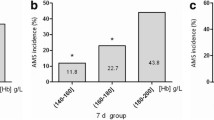Abstract
Chronic mountain sickness (CMS) or Monge's disease is a clinical entity observed among residents at altitude characterized by polycythaemia increased above the physiological level due to altitude adaptation. From correlation studies of haematocrit with ventilation rate of healthy and diseased native high altitude residents (4,540 m) it was found that CMS is a clinical manifestation of aging. The higher the altitude the sooner the symptoms of excessive polycythaemia will become evident.
Similar content being viewed by others
References
BALDWIN, F., COURNARD, A. and RICHARDS, D.W. (1948): Pulmonary insufficiency. I Physiological classification, clinical methods of analysis, standard values in normal subjects. Medicine, 27: 243–278.
HURTADO, A. (1964): Animals in high altitude: resident man. In: Adaptation to the Environment. Handbook of Physiology. Section IV, 843.
LAHIRI, S. (1971): High Altitude Physiology: Cardiac and Respiratory Aspects. Ciba Foundation Symposium. R. Porter and J.Knight (ed.), Churchill, Livingstone, Edinburgh and London. p. 58.
LOZANO, R., TORRES, C., MARCHENA, C., WHITTEMBURY, J. and MONGE, C.C. (1969): Response to metabolic (ammonium chloride) acidosis at sea level and at high altitude. Nephron, 6: 102–109.
MONGE, M.C. (1942): Life in the Andes and chronic mountain sickness. Science, 95: 79–80.
MONGE, M.C. and MONGE, C.C. (1965): High-Altitude Diseases: Mechanism and Management. C.C.Thomas Publ., Springfield, Illinois.
MORET, P.R. (1971): Coronary blood flow and myocardial metabolism in man at high altitude. In: High Altitude Physiology: Cardiac and Respiratory Aspects. R. Porter and J. Knight (ed.). Ciba Foundation Symposium. Churchill, Livingstone, Edinburgh and London, 131–148.
PENALOZA, D., SIME, F. and RUIZ, L. (1971): Cor pulmonale in chronic mountain sickness: present concept of Monge's disease. In: High Altitude Physiology: Cardiac and Respiratory Aspects. R.Porter and J.Knight (ed.). Ciba Foundation Symposium. Churchill, Livingstone, Edinburgh and London, 41–60.
SEVERINGHAUS, J.W., BAINTON, C.R. and CARCELEN, A. (1966): Respiratory insensitivity to hypoxia in chronically hypoxic man. Resp. Physiol., 1: 308–334.
SIME, F. (1973): Ventilación humana en hipoxia crónica. Etiopatogenia de la enfermedad de Monge o desadaptación crónica a la altura. Tesis Doctoral, Universidad Peruana Cayetano Heredia. Lima.
SORBINI, C.A., GRASSI, V., SOLINAS, E. and MUIESAN, G. (1968): Arterial oxygen tension in relation to age in healthy subjects. Respiration, 25: 3–13.
WHITTEMBURY, J. and MONGE, C.C. (1972): High altitude, haematocrit and age. Nature (Lond.), 238: 278–279.
Author information
Authors and Affiliations
Rights and permissions
About this article
Cite this article
Sime, F., Monge, C. & Whittembury, J. Age as a cause of chronic mountain sickness (Monge's disease). Int J Biometeorol 19, 93–98 (1975). https://doi.org/10.1007/BF01463864
Received:
Issue Date:
DOI: https://doi.org/10.1007/BF01463864




